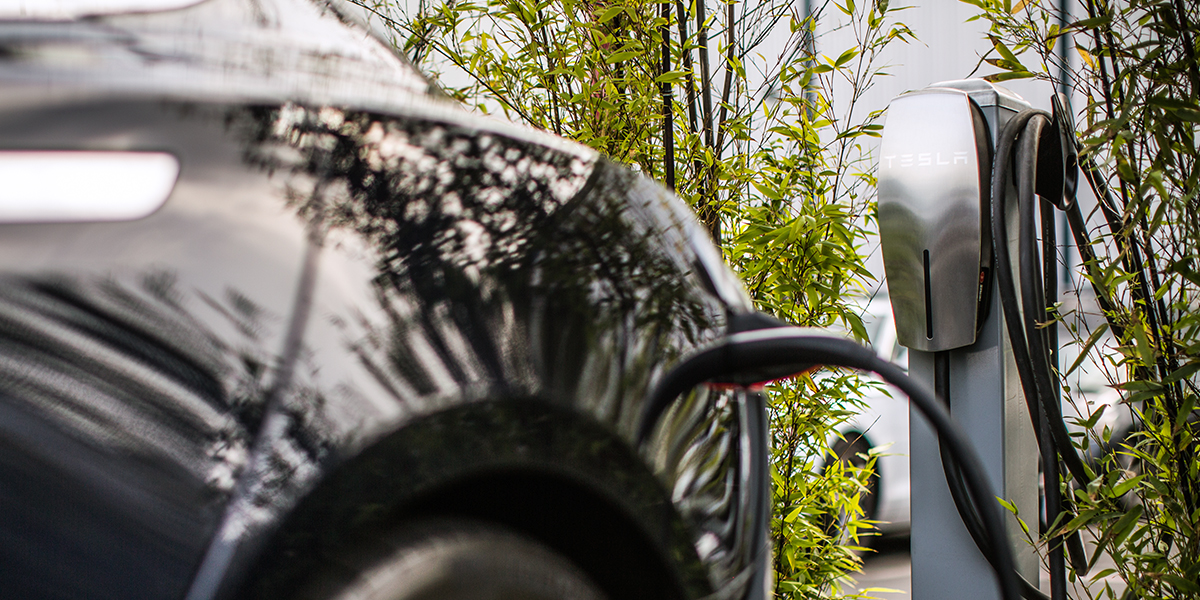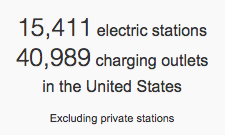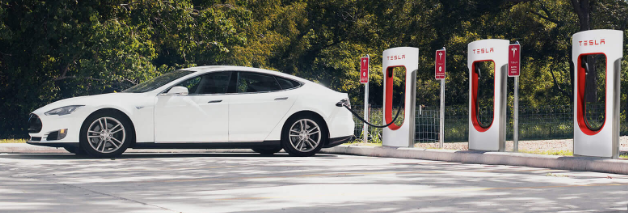Note: Since posting this article, which was based on the CNBC.com article, I received a link to the actual UBS report and have updated the section reference home charging.
According to an article on CNBC.com, UBS analyst Colin Langan predicts that “Tesla will have to invest up to an additional $8 billion in its network of high-speed charging stations in the U.S. alone if it wants to make recharging a car as convenient as filling the gas tank.”

The article further quotes Langan’s research note (Update: After posting this article, I received a link to the UBS report – you can view it here): “ … geospatial imaging of the United States suggests Tesla will have to add about 30,000 new chargers to compete with the network of gas stations across the country, at an estimated cost of $250,000 per station.”
I won’t speak to Langan’s motivations behind this data and analysis and his March 2 research note on Tesla (Langan is a known bear on Tesla stock), but according to CNBC: “Langan’s latest note reiterates a “sell” rating on the stock, with a $160 price target. Tesla shares were recently trading at $250.56 on Friday (March 3, 2017) afternoon.”
So what’s wrong with this picture? Oh, let me count the ways.
Langan’s model and assumptions are similarly flawed as to those I saw back in 1998-1999 during the dotcom bubble. Projections like Langan’s are a spreadsheet exercise where the math is not the problem, but the underlying assumptions actually have little basis in reality.
Let’s Break Down the Langan Assumptions
1. Langan ignores how electric vehicle (EV) owners actually charge their vehicles.
According to CNBC, “The UBS analysis put the average drive time to a Tesla charging station at about 30 minutes, compared with an average of only 4 minutes to the nearest gas station.”
I’ll assume that this UBS analysis is correct, but it simply ignores the reality of when and where most EV owners charge their vehicles. There are five core use cases and locations for EV charging:
- Residential: At a single-family home or apartment/condominium complex.
- Workplace: Especially in markets where EV adoption is high, most office parks and office buildings have installed chargers for employees.
- Destinations: Hotels, resorts, wineries, ski resorts, theme parks, etc.
- Local Public Charging: Located at restaurants, shopping malls and downtown shopping/entertainment area parking lots and garages.
- Interstate/Intrastate Highways: Currently the majority of these charging stations, typically located at restaurants, gas stations, food stops, outlet malls and similar locations, are Tesla Supercharger sites.
With the 60 kWh battery Tesla Models S and X, owners of that model have a realistic range of about 205 miles. Owners of the 90 kWh and 100 kWh battery models can expect 275-300 miles of range. The Model 3 has a promised range of 215 miles, but I’ll peg it closer to 205-210 for real-world driving and leaving a few miles to spare.
With a range of 200+ to 300 miles (today, and increasing in the coming years), the primary public charging needs of Tesla owners are destinations (long dwell/slow charge) and interstate/intrastate (short dwell/fast charge).
Langan’s model simply ignores these realities and instead uses a flawed comparison to gas stations.
Gas stations are an old-world concept based on an eco-system built around the storage and delivery of gas and diesel. It wouldn’t make sense, for example, to have gasoline storage tanks located at millions of homes, office parks and hotels/resort. As a result gas and diesel fuel is delivered by truck to gas stations, many of which are located within a few miles of homes and multi-family units.
With electric vehicles, however, this highly centralized model of “refueling” stations will increasingly only be critical for long-distance trips. As all homes and businesses are wired for electricity, this fundamentally changes the “refueling” distribution model. EV charging, albeit not necessarily done quickly, is possible wherever there is an electrical outlet.
Charging electronic devices such as laptops, smartphones and tablets is the better analogy for EV charging, instead of comparing to refueling at gas stations. As consumers we have learned to monitor how much power we have left with these electronic devices and plug in to recharge at home, work, coffee shops, the airport and again, wherever there are available plugs.
But like these electronic devices, according to a study from the Idaho National Laboratory, the majority of EV owners charge their vehicles primarily at home. The study also found that EV owners with access to chargers at both home and the workplace performed 98% of their charging events either at home or work and only 2% at other locations.
Equating the need for Tesla Superchargers at the same volume and density to gas stations is simply illogical.
2. Langan downplays the use of home chargers.
In the UBS report Langan concedes in a “likely questions” section and almost as an afterthought that “Most owners will likely do the majority of their routine charging at home.” He goes on: “If EVs are their main form of transport, EV buyers will want a reasonable backup (forget to plug in, power outage, etc.) to ensure they can still get to work. We believe the 31 minute scenario, using in our bull case, addresses this minimum backup needed.”
This is just idiotic as any EV owner knows. Forgetting to plug in your EV, especially if range is low, is just something that EV drivers don’t do. Charging becomes second nature just like, oh dare I say, remembering to fill your gas tank. And if the power goes out, that nearby charging station that Langan calls for will likely also be without power too. D’oh.
In additional comments sent to CNBC, Langan noted that “only 47 percent of Americans have dedicated parking for a charger, and those numbers are lower in Europe and China.”
There are approximately 75 million owner-occupied households in the US, with 80 percent, or roughly 60 million homes, having a garage or carport. There is an additional approximate 44 million renter-occupied households, 35 percent or 15 million of which are living in single-family homes.
Using my handy calculator, this would suggest that roughly 72 million households in the US have access to an electrical outlet in their garage or carport. So by my estimate, 61 percent (not the 47 percent Langan suggests) of the approximate 118 million US households likely have access to “dedicated parking for a charger.”
And while a bit dated, a 2013 Edmunds analysis of US Tesla Model S buyers revealed that 77 percent had an income above $100,000. While I did not find any data to support this, my assumption is that the vast majority of Tesla buyers who own a home have also installed a home charging unit and primarily charge at home.

The bigger challenge and unknown, especially as the Model 3 deliveries take off in 2018, is where will a growing number of young, urban Tesla owners who live in apartments and condos charge their cars? For these Tesla owners, I expect most will have access to chargers at their apartment complexes, workplaces or both.
Some of these Tesla owners who live or work near a Supercharger will certainly try to use them as their primary charger. Tesla recognizes this of course and will continue to tweak their Supercharger policies to minimize this type of use. In fact, while it might not be overly popular with some owners, Tesla can reduce overuse at local Superchargers by adjusting pricing policies as this article on workplace EV charging pricing policies reveals.
3. Langan completely ignores the Tesla Destination Charger network.
Globally, Tesla has 4,148 Destination Charger sites and 7,110 connections, according to the company’s Fourth Quarter & Full-Year 2016 Update. That is an average of 1.71 chargers per Destination Charge site. By my manual count on March 3, 2017 from the Tesla Destination Charger web page, I estimated 696 (+/-) Destination Charger locations in the US. That would equate to 1,190 actual connections.
The 4,148 global Destination Charger sites was a 120% increase from 1,884 at the end of 2015. If we assume a growth rate of 100% in 2017, there would be roughly 1,400 sites and 2,400 charger connections in the US.

Many of the Destination Chargers are located at hotels and resorts which are a core charging need among EV owners. On a recent weekend my wife and I drove 3 hours up the California coast and stayed at resort in a very isolated area. This resort had two Tesla Wall Chargers and an additional Level 2 charger that would connect with an adapter to a Tesla.
Upon arrival we checked in to the resort and quickly added a little safety zone of about 35 miles as we were headed to the next town for a birthday party. That night and the following night I simply plugged my Tesla into the Tesla Wall Charger and I was good to go for the subsequent days. On our drive back home I did stop off at the Napa Supercharger just to provide a little buffer, though it wasn’t needed as I would have arrived home with about 25 miles of battery range remaining.
My point of the personal anecdote is that my example is typical of real-world charging needs. With the current Tesla 60kWh battery, owners have a realistic range of about 205 miles. That is enough range to cover the daily round-trip commutes and chore trips for 99 percent of Americans. These charging needs can and should be met with charging at home – whether a single-family home, condo/townhouse or apartment complex.
The 200+ mile trips are and will be met by a growing number of both Tesla Destination Chargers and Superchargers.
4. Langan ignores the fast-growing public charging networks.
Home charging and Tesla’s network of Superchargers and Destination Charger locations are clearly the most convenient and quickest way to charge a Tesla. But while Tesla has a proprietary charging connector, Tesla’s come with adapters for all major charging networks.
If you need a charge in the US there are nearly 41,000 charging outlets and more than 15,400 charging stations, according to the US Department of Energy, Alternative Fuels Data Center.

Subtracting the 346 US Supercharger stations and my estimate of roughly 700 Destination Chargers would mean US Tesla owners currently have access to an additional 14,350 or so charging stations. And looking globally, the EV charger market is forecast to grow from more than 1 million units in 2014 to more than 12.7 million units in 2020, according to the EV Charging Infrastructure report by IHS Inc. While these chargers are primarily a mix of Level 1 and Level 2 chargers, the point is there is an increasing number of EV chargers available both in the US and major markets throughout the world.
In Langan’s narrow view, however, Tesla pretty much has to build out by itself the Supercharger network to enable owners to charge their cars 24/7. This is simply ridiculous and is somewhat akin to arguing that Ford in the 1920s would need to build enough gas stations to fuel all of their cars.
5. “Tesla wants to make recharging a car as convenient as filling the gas tank.”
The real challenge with making electric vehicle charging as convenient as filling the gas tank is NOT the number of charging stations, but rather the time it takes to charge.
I’ve never actually seen a statement from Tesla or Elon Musk that they want “to make recharging as convenient as filling the gas tank.” But regardless of whether that specific goal has been stated or not, I believe the actual long-term priority is making charging nearly as quick as filling the gas tank of a vehicle powered by an internal combustion engine.
So what Langan actually misses in his analysis is the future investment Tesla will need to make in upgrading the Supercharger network to enable a charge time of under 10 minutes.
In 2012 Tesla CTO JB Straubel said that Tesla aims to bring charging time down to 5 to 10 minutes: “It’s not going to happen in a year from now. It’s going to be hard. But I think we can get down to five to 10 minutes.”
And in December of 2016, Elon Musk hinted via some Tweets that Tesla would at some point upgrade Superchargers with greater than 350 kW charging capability. With current Superchargers powered at around 100 kW, Tesla owners can achieve a charge of about 170 miles in around 30 minutes.
When these new chargers are rolled out, Tesla would likely achieve a charge of 150-200 miles and meet Straubel’s goal of charging in under 10 minutes.
And while one can only guess at the costs for the higher-powered Superchargers and timeframe for the upgrade, Langan seemed to miss one of the most important components of the future investment required to scale the Supercharger network. And he got most everything else wrong too.
6. Tesla needs to add 30,000 new Superchargers.
According to Langan, “… geospatial imaging of the United States suggests Tesla will have to add about 30,000 new chargers to compete with the network of gas stations across the country, at an estimated cost of $250,000 per station.”
As I’ve outlined above, this is simply hogwash. Tesla clearly does need to expand its network of both Superchargers and Destination Chargers to meet the growing demand from Model S, X and future Model 3 owners.
While not based on any concrete evidence or numbers, I would estimate that Tesla needs to double both the number of Superchargers sites and chargers per location in the next few years. In California, for example, I believe Tesla’s biggest need is not so much more Supercharger sites, but more chargers per location.

In most of the popular long-distance routes such as along Interstate 5, there are now Superchargers located frequently enough to handle a 200-mile range. But on holidays and high-traffic times, there can be back-ups as owners wait for fellow drivers to complete their 30-60 minute charges.
There is currently an average 6.4 connections per each Supercharger site. I would expect to see Tesla doubling that average as part of the announced expansion. And when combined with Musk’s hints at super-fast chargers at greater than 350 kW, access and wait times should be sufficient in most regions.
So let’s do a little modeling of our own:
- Doubling the number of US Supercharger sites: 350 X $250,000 = $87,500,000
- Doubling the number of US Destination Charger sites: 700 sites X 1.71 units X $400* = $478,800 (*Wall chargers retail for $550, I’m assuming Tesla is not using a traditional 100% retail mark up, so using $400 as a high estimate of their cost)
That would get us to an investment in 2017 of approximately $88 million, or $264 million over a 3-year period.
That is nowhere near the $2-$8 billion in the US alone that analyst Langan is suggesting. I’m sure my models have some flaws as well, but I just don’t see any basis for the magnitude of his numbers. And fundamentally, Langan’s numbers are simply based on a ludicrous comparison to the reach and proximity of gas stations.
 Announcing the acquisition of EVAdoption by Paren →
Announcing the acquisition of EVAdoption by Paren →
5 Responses
Yes, your figures are much more sensible than Langan’s. I suspect his article was simply a hatchet job bought and paid for by the oil industry. Clearly EVs are the future, but some people prefer to put their heads in the sand and pretend that gas and oil will still be relevant in ten years from now.
Great post. Those who don’t have a Tesla don’t realize how one manages the battery and is always aware of how/when to charge. I don’t need the “convenience of gas stations” because I have one in my garage now!
Great analysis, and spot on!! Very sound. Bravo Loren.
Thanks Brandon, appreciate it!